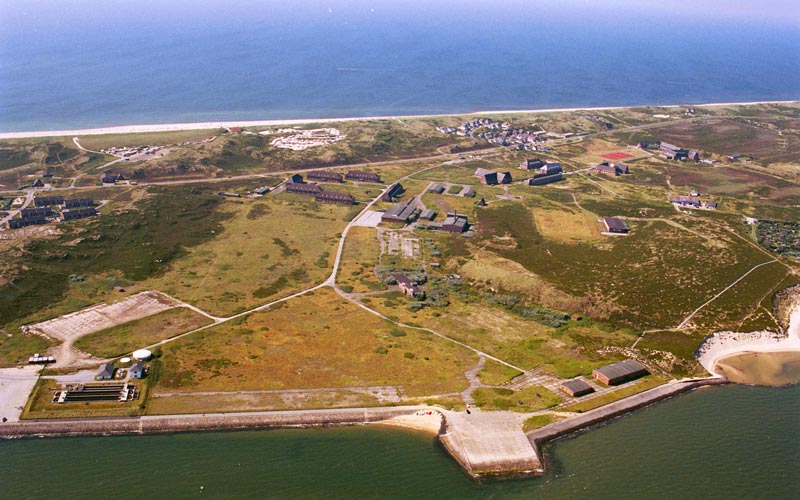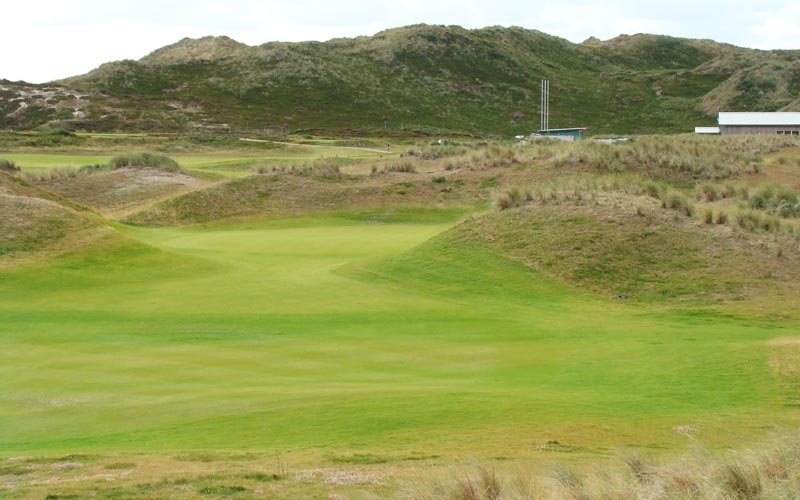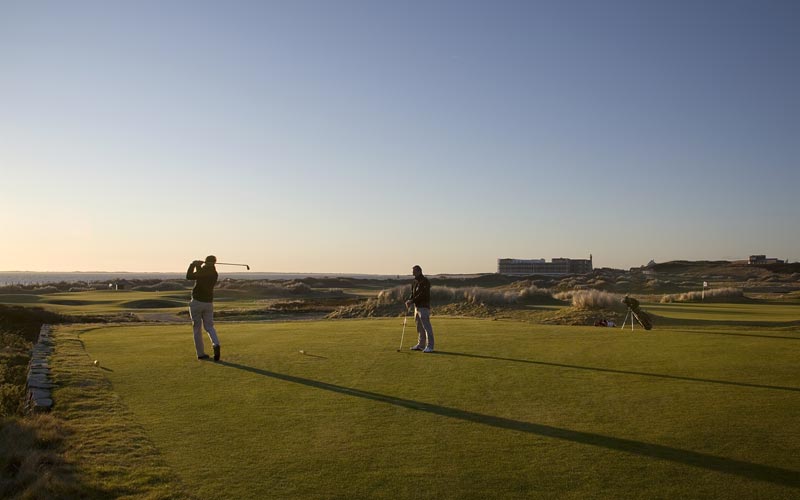Feature Interview with Rolf-Stephan Hansen
February, 2011
1. Please describe the history of the site that is now the Budersand golf course.
During the Second World War the site was used as a military base for water-airplanes. The German government closed the site and left it empty until fifteen years ago.

This aerial was taken in 2003 and is of the military base lying fallow. In the bottom right hand corner, the much photographed par three fifteenth hole would…

… be built and is just one of many holes that makes Budersand ….
2. What is your background?
I am a qualified landscape architect since 1994. I also successfully studied golf gourse architecture from 2000-2002 at the European Institute of Golf Course Architects.
3. Once you had the idea that a golf course would be an ideal use for the land, what were your next several steps?
First steps were to clarify the planning permissions together with the planning authorities. After getting the green light and the right signals from the authorities, the next step was to find an investor.
4. How and where did you formulate your ideas on golf course architecture? Did any courses or architects serve as particular influences?
During my study of the golf course architecture and with my passion for the game, I travelled around many links golf courses, especially those in Ireland and Scotland. Also my fundamental knowledge as a landscape architect gave me a strong ability to visualize certain aspects accreditting to design and character of links golf courses. I have a great admiration and respect for the work of Martin Hawtree, who confirmed that I was on the right path.
5. What kind of soil conditions did you have to work with at Budersand?
I was lucky to work with pure sand 0/2 mm. The disadvantage of such soil was its high percolation rate. Therefore it took more time to establish the fine turf of Budersand. In this regard, we were very fortunate to have Mr Bruce Jamieson as the advisor for agronomy at Budersand.
6. Is it true that a large number of buildings had to be destroyed to make a place for the fairways?
Twenty-six old buildings and barracks were demolished during construction. Altogether ten hectars of roads and buildings were changed with 160.000 m³ of earth movement to a links landscape.
7. Many of the dunes across the course were manufactured by you. Was the fact that you are a native to the island of Sylt helpful in getting the dunes to look natural?
Definitely yes, and my background as a landscape architect was quite useful as well.
8. What grasses did you use to stabilize the dunes?
The dunes had been hydroseeded with the following mixture:
30% Festuca rubra ssp. commutata
30% Festuca rubra ssp. litoralis
30% Festuca rubra ssp. rubra
10% Agrostis capillaris
Additional plantings of marram grass (Ammophila arenaria) helped stabilize the dunes quickly.
9. Located at the southern tip of the island, Budersand is hard along the North Sea. How did you make allowances for the wind within your design?
With the very strong winds, the routing is very important for the variety and the technical interest of the players. For this reason I have designed the course with two loops ending near the clubhouse and offering a variety of different playing directions.
10. What grass scheme did you go with to give players the genuine option to hit low, running shots underneath the wind?
Our grass schemes were as follows and allow for plenty of run:
Fairways
30% Festuca rubra ssp. commutata
30% Festuca rubra ssp. litoralis
30% Festuca rubra ssp. rubra
10% Agrostis capillaris
Greens
40% Festuca rubra ssp. commutata
30% Festuca rubra ssp. litoralis
30% Agrostis tenuis
11. Budersand is the first non-member, green fee only course in Germany. Is there a learning curve involved for people in playing a links course? Does the German golf population understand that yellow turf in the summer is good as links courses play best fast and firm? Do they understand that unlucky bounces are part of the character of links golf?
Unfortunately, the average German golfer has problems with the hard ground, the deep bunkers, fast greens and the dunes. German golfers have mostly not learned to play such style of golf, because they generally only know inland golf courses. Because golf is slowly maturing in Germany, we hope that the German golfer will start to appreciate playing links golf courses like Budersand and will gain an understanding to the unique demands that links golf places on the golfer.
12. Both from a big picture point of view (the quality of the holes) and from a detail perspective (the way some of the fairway contours feed into bunkers, for instance), Budersand is a great design success. How do you account for getting so much right in your first course design?
The success is based on three major aspects. One being the fantastic site with its unique beauty and panorama, secondly the fundamental and stable financial platform and last but not least my own and the owner’s highly motivated attitude to the whole project, together with the successful grow-in period and excellent on-going greenkeeping by course manager Jim Ellis.

The bunker on the inside of the dogleg second hole plays much larger than its actual footprint, thanks to the slope of the land and how only short grass feeds into it.
13. Talk about the genesis of the thirteenth hole.
The investor really liked the character of Lahinch´s Dell. The Dell at Lahinch cannot be beaten as one of the best short holes in links golf, in addition to the Postage Stamp at Troon. My aim was to create something special without copying. Budersand’s thirteenth has received its very mystical number, because it unites happiness and misfortune. Standing on an elevated tee set into fantastic old dunes the golfer is confronted by two towering dunes to the front right and left to this 155 m long Par 3, with a little small gap between them. Either one can see the flag middle or left on the green or the flag is right on the green, hidden behind a dune crest.

Rolf-Stephan Hansen’s version of the Dell Hole has the middle and left portion of the green visible from the tee.

When the wind blows a certain way, the golfer might even catch a glimpse of the flag when it is tucked away to the right.
14. Please describe a favorite hole and what you like so much about its design.
I do not have a favourite hole, but I can describe for instance the strategy of the 17th hole: A ditch runs frighteningly through the fairway in form of a horse shoe. It is a par five for the resort guests but a par four for the professionals from a slightly forward tee. For a professional to reach the green of this 467 m long hole in two shots, he has to risk a shot near this ditch while still being as long as possible. The give and take is both sophisticated and demanding. I did a similar thing at the third hole where the professional tee is ahead of the resort tees, again making for a challenge for the accomplished golfer while letting the resort guest have fun.
15. What is your philosophy in regards to fairway bunkers? Given the style of pot bunkers that you utilized, they certainly extract a penalty for those that get into them from the tee.
There was a very strong, practical reason for going with pot bunkers and that was the wind. As it sweeps across the island, it could easily blow the sand out of most other bunker styles. I set my bunkers strategically into the holes with a risk and win situation regarding the following shot into the green.

This golfer has a shot but if his tee ball had finished a few feet closer to the front of the bunker, he would have to pitch out sideways.
16. New course construction in North America and Europe is at a low point for the past twenty years. Are you interested in doing restoration work?
I think restoration work is a very interesting task to enhance the quality of golf courses. Restoration is also very important to solve problems of boring design and poor maintenance. At the moment I am working on two very interesting restoration projects which I hope to update your readers on at a later date.
17. Are there other coastal opportunities either in Germany or Denmark?
With all the legislation protecting links land as a site of ecological interest it is unfortunately not possible to create a new links course in Germany or Denmark.
18. On the world stage, Germany had a great year via Kaymer and Langer. What is the current golf scene like in Germany?
Unfortunately it is not booming at the moment, but with the success of a person like Martin Kaymer we hope that this will give a spark to new golfers and obviously more high quality golf courses in the near future.
The End











